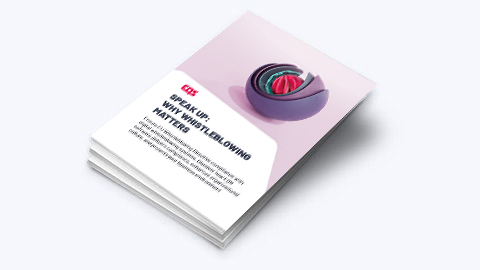Why Conflicts of Interest management belongs at the heart of your compliance strategy

Conflicts of interest (COIs) rarely announce themselves with drama. They emerge quietly – in vendor relationships, board appointments, side businesses – and if left unmanaged, erode the trust and integrity that holds your organization together.
The reality is that no company is immune. The true measure of compliance maturity isn’t the absence of conflicts, but how openly and systematically you manage them.
What is a Conflict of Interest?
A conflict arises when personal interests – emotional, relational, or financial – compromise a person’s ability to make objective, ethical decisions at work.
We often associate conflicts of interest with major scandals and headlines, but most conflicts occur in mundane, everyday situations that slip past unnoticed. And while discussions typically fixate on romantic relationships or family ties, the real landscape is much broader.
Common examples include:
- Accepting substantial gifts or hospitality from vendors or clients
- Favouring specific organisations or suppliers due to personal relationships
- Holding financial stakes in suppliers, partners, or competitors
- Serving on external boards that could influence internal decision-making
- Running a side business that overlaps with professional responsibilities
The appearance of a conflict of interest can be just as damaging as an actual one, as Steph Holmes from EQS Group noted in a recent article. Perception matters.
Why COI disclosure is not optional
If conflicts of interest management isn’t yet on your compliance agenda, ask yourself why.
Perhaps your compliance framework is still maturing, focused primarily on meeting direct regulatory requirements. Maybe trust runs deep in your organization, trust runs deep, so potential conflicts go unspoken: “We all know each other, so there’s no problem.” Or perhaps, because you don’t handle procurement, you’ve assumed conflicts of interest don’t apply to you.
And if you’re honest? Maybe you are afraid of what a closer look might uncover.
But conflicts don’t disappear if you sweep them under the rug. The only responsible approach is to identify them, however uncomfortable, and address them openly.
At the core, effective conflicts of interest management ensures:
- Decisions are made in the organisation’s best interest, not influenced by personal gain or relationships
- Leaders can spot spot risks early and take proportionate action, such as recusing an employee from a decision or bringing in an independent reviewer
- High-exposure roles – procurement, leadership – are protected from accusations through transparent disclosure mechanisms
- Employees can leverage their experience and networks without crossing ethical lines
When leaders are transparent about their own potential conflicts, they set the tone for a culture of integrity. This not only builds internal trust but also demonstrates to regulators, stakeholders, investors, and customers that your organization takes ethics seriously.
The cost of inaction? Legal penalties. Regulatory scrutiny. Reputational damage. Investigations that disrupt operations, drain resources, and crush morale. Once exposed, companies often face tighter oversight and diminished trust, both internally and externally, for years.
Four steps for managing conflicts of interest effectively
Managing COI is about creating simple systems and habits that make ethical decisions easier for everyone.
Here’s how to set your organisation up for success.
Want the complete methodology? Download our white paper, 14 essential requirements for effective conflict-of-interest management, to learn more.
- Lay the ground work for your ethics policy
Start by mapping where conflicts are most likely to surface. Sales and procurement are high-exposure areas – these risks should anchor your entire system.
Next, build a clear, straightforward COI policy tailored to your organization. Define exactly when employees must disclose: at hiring, when new conflicts arise, or through annual certification. Make the policy universal – not exceptions, even for the board.
Then, expand your view beyond employees. Require partners, suppliers, and contractors to confirm they follow your code of conduct and enforce COI rules in their own operations. Consistent expectations across all business relationships reduce systemic risk.
- Build a secure and practical COI disclosure system
Disclosure should be frictionless. Provide a secure, integrated platform where employees can submit COI information without hassle. Keep this disclosure channel separate from other reporting mechanisms to avoid confusion.
Your system must handle complexity: roles change, relationships evolve, and multi-party connections must be mapped and tracked over time. Since COI data often includes sensitive personal information, apply strict privacy and data protection standards.
Finally, automate reporting wherever possible. A reporting-ready system saves compliance teams time and delivers insights without manual data wrangling.
- Keep everyone informed and engaged
Even the best policy fails if people don’t understand it. Communicate your COI rules clearly and consistently.
Training should be brief and scenario-based. Focus on real-life situations that employees will recognize and how to navigate them, not abstract definitions. Regular communication keeps COI management visible and helps employees feel confident about what to disclose and when.
- Monitor, review and improve the compliance framework
Review every disclosure using a consistent, structured process. A review committee ensures fairness and transparency in decision-making.
Look for patterns that might point to broader risks or gaps in your policy.
A strong COI program isn’t static – it evolves as your organization does.
The true measure of your compliance maturity
In a complex business environment, conflicts of interest are inevitable. What separates strong compliance cultures from weak ones is not the absence of conflicts but the consistency and transparency with which they are managed.
A clear COI program, supported by open communication and simple disclosure processes, transforms potential risks into opportunities to strengthen trust. That’s good business.
Ready to strengthen your approach?
Our white paper outlines the practical requirements for building an effective COI framework.




